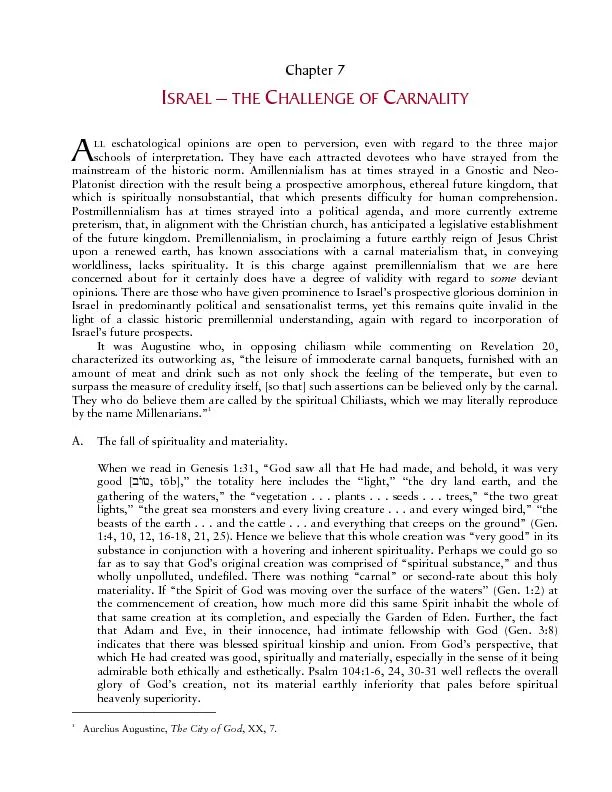PDF-REMILLENNIALISM Bless the Lord, O my soul, O Lord my God, You
Author : liane-varnes | Published Date : 2016-05-18
REMILLENNIALISMJust as the tabernacle was never intended to be a settled item in the plan of redemption but was to point to Christ
Presentation Embed Code
Download Presentation
Download Presentation The PPT/PDF document "REMILLENNIALISM Bless the Lord, O my..." is the property of its rightful owner. Permission is granted to download and print the materials on this website for personal, non-commercial use only, and to display it on your personal computer provided you do not modify the materials and that you retain all copyright notices contained in the materials. By downloading content from our website, you accept the terms of this agreement.
REMILLENNIALISM Bless the Lord, O my soul, O Lord my God, You: Transcript
REMILLENNIALISMJust as the tabernacle was never intended to be a settled item in the plan of redemption but was to point to Christ. and all that is within me,. bless His holy name.. He has done great things,. He has done great things,. He has done great thing,. Bless His holy name.. Bless the Lord, O my soul,. and all that is within me,. A key component of spiritual leadership is helping others tap into what nourishes their . soul… . Learning to be present to the One who is always present. . “Behold God is my helper; the Lord is the sustainer of my soul.” Psalm 54: 4 NASB. Ye people of His choice. Stand up and bless the Lord your God. With heart and soul and voice. Stand . Up . and . Bless . the . Lord - 21. Though high above all praise. Above all blessing high. Who would not fear His holy name. . Celebrate. . . Recovery. Blessed Assurance. . Blessed assurance, Jesus is mine. O, what a foretaste of glory divine. Heir of salvation, purchase of God. Born of His Spirit, washed in His blood . Ye people of His choice. Stand up and bless the Lord your God. With heart and soul and voice. Stand . Up . and . Bless . the . Lord - 21. Though high above all praise. Above all blessing high. Who would not fear His holy name. Water You turned into wine. Opened . the eyes of the blind . There’s . no one like You. None . like You . Into the darkness You shine. Out of the ashes we rise. There’s no one like You. None like You . Psalm 103. 4 Questions. What’s the big idea?. What does it say about me?. What does it say about God?. How should I respond?. What’s the Big Idea?. “Bless the Lord”. What’s the Big Idea?. “Bless the Lord” = give thanks to God. Oh my soul. Worship His Holy name. Sing like never before. Oh my soul. I'll worship Your Holy name. The sun comes up. It's a new day dawning. It's time to sing Your song again. Whatever may pass. And whatever lies before me. mer, Creator. Our Redeemer – the Lord Almighty is his name- is . the Holy One of Israel. Is 47:4. Julia Cady Cory, 1902. KREMSER. . TRINITY HYMNAL . 97. CCLI #977558. 1. We praise you, O God, . my soul. Worship His holy name. Sing like never . before, O . my soul. I . worship Your holy . name. The . sun comes up, it's a new day dawning. It's time to sing Your song again. Whatever may pass, and whatever lies before me. Land that I love. .. Stand . beside her, and guide her. Through . the night with a light from above. .. From . the mountains. , . . . . . . . . to the prairies,. . To . the oceans, white with . Love, Guy and Ann McDaniel Nov. 19, 2017. The Early Settlers had. . Plenty of Water Fowl. . Many turkeys. . Much Venison. . Lots of Fish like cod and bass. . Indian Corn from which they made meal. Love, Guy and Ann McDaniel Nov. 19, 2017. The Early Settlers had. . Plenty of Water Fowl. . Many turkeys. . Much Venison. . Lots of Fish like cod and bass. . Indian Corn from which they made meal. soul... . O my soul. Worship His holy . name. Sing like never before… O my soul. I'll worship Your holy . name. The sun comes up, . it's a new day . dawning. It's time to sing . Your song . again. Whatever may pass, .
Download Document
Here is the link to download the presentation.
"REMILLENNIALISM Bless the Lord, O my soul, O Lord my God, You"The content belongs to its owner. You may download and print it for personal use, without modification, and keep all copyright notices. By downloading, you agree to these terms.
Related Documents














